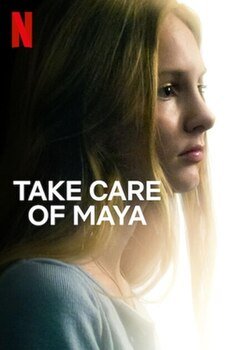A Comprehensive Review of the Netflix Documentary “Take Care of Maya” (2023)
A Family Torn by the System Meant to Protect It

Introduction
The Netflix original documentary Take Care of Maya (2023), directed by Henry Roosevelt, is a searing, emotional, and deeply disturbing examination of what happens when a child welfare system, designed to protect, becomes the very instrument of trauma and destruction.
Told through the real-life ordeal of the Kowalski family, the documentary unearths a growing pattern of systemic failure, where overzealous child protection agencies, ill-informed medical professionals, and the courts converge to fracture already vulnerable families. While centered on Maya Kowalski’s rare medical condition, Complex Regional Pain Syndrome (CRPS)—the film is a broader indictment of a system that often assumes parental guilt over partnership, and leaves irreversible damage in its wake.
Summary of the Documentary
Maya Kowalski, a spirited nine-year-old girl from Florida, began experiencing chronic, debilitating pain in 2015. Her mother, Beata Kowalski, a registered nurse, tirelessly sought answers and after countless visits and consultations, Maya was diagnosed with CRPS, a rare and controversial neurological pain disorder.
Beata and her husband, Jack, followed the recommendations of Dr. Anthony Kirkpatrick, a pain management specialist, which included a controversial but effective treatment: a ketamine-induced coma administered in Mexico, followed by outpatient care and low-dose ketamine infusions in the U.S. The treatment worked, until Maya relapsed in 2016 and was taken to Johns Hopkins All Children’s Hospital.
There, the medical staff questioned Maya’s diagnosis and Beata’s assertiveness. Instead of seeking to understand Maya’s complex condition or partnering with her care team, hospital staff contacted Child Protective Services. Dr. Sally Smith, a child abuse pediatrician contracted by the state, alleged that Beata was fabricating Maya’s illness, a diagnosis known as Munchausen syndrome by proxy (medical child abuse).
Maya was immediately placed in state custody, denied access to her mother for nearly three months. Despite court hearings, documentation from Maya’s original physician, and Beata’s record-keeping, the system refused to reunite them. On January 8, 2017, Beata died by suicide, believing that her death was the only way to free her daughter. Six years later, a Florida jury awarded the family $261 million in damages, finding the hospital and child protection staff guilty of medical negligence, false imprisonment, emotional abuse, and fraudulent billing.
A System That Punishes the Proactive
A. Misuse of Power in Child Protection
The Kowalski case reveals the extraordinary power wielded by child abuse pediatricians, whose opinions often determine custody outcomes. In Maya’s case, Dr. Sally Smith who had already been implicated in numerous controversial removals, served as both investigator and gatekeeper, with little accountability or oversight. The courts deferred to her, despite her limited understanding of CRPS or Beata’s supporting documentation.
This is a recurring theme in U.S. child welfare:
-
Presumption of guilt: Especially in families with rare medical conditions.
-
Aggressive separation: Children are removed before thorough investigations are conducted.
-
Poor interdisciplinary understanding: Medical complexity is often equated with fabrication or abuse.
Smith’s involvement is not isolated. In fact, Take Care of Maya indirectly connects to an alarming national pattern. According to investigative reporting from USA Today and The Marshall Project, dozens of families have been falsely accused of medical child abuse based on similar evaluations.
Trauma Multiplied: The Consequences of Family Separation
A. For the Child
Maya was already coping with physical pain and medical uncertainty. Being taken from her parents without warning, denied familiar treatment, and isolated from her primary caregiver triggered what developmental psychologists call “compound trauma.” The consequences are well-documented:
-
Post-Traumatic Stress Disorder (PTSD)
-
Depression and anxiety
-
Trust issues with adults and institutions
-
Regression in cognitive and emotional development
B. For the Parent
Beata’s suicide was not just the result of separation, it was the culmination of psychological, emotional, and legal warfare. Her advocacy was misconstrued as aggression, her medical knowledge dismissed as manipulation, and her motherhood criminalized.
C. For the Family Unit
The trauma of the Kowalski family cannot be overstated. Jack, Maya’s father, had to balance compliance with legal directives against his desire to protect and support both his daughter and wife. Maya’s brother, Kyle, was a collateral victim, another child robbed of a parent by the very system meant to safeguard children.
The Power of Documentation and the Burden on Families
Beata’s meticulous records, call logs, and medical history became instrumental in the eventual legal victory. But that in itself is a tragedy: a grieving, traumatized family had to prove their innocence over years, while facing grief, loss, and media scrutiny.
Reform Recommendations
-
Mandated Family-Centered Assessments: Before separating a child, systems must engage family-strengthening professionals trained in trauma and medical complexity.
-
Checks on Child Abuse Pediatricians: There must be independent oversight of state-appointed child abuse investigators.
-
Transparency and Parental Rights Education: Families need legal literacy to navigate these complex processes and protect their rights.
-
Prioritize Support, Not Suspicion: Offer wraparound support, counseling, medical case reviews, respite not coercion and courtroom battles.
Conclusion
Take Care of Maya is a devastating documentary, not just because of one family’s suffering but because their story is not unique. Across the world, families of medically fragile children are navigating systems that are often adversarial rather than supportive.





